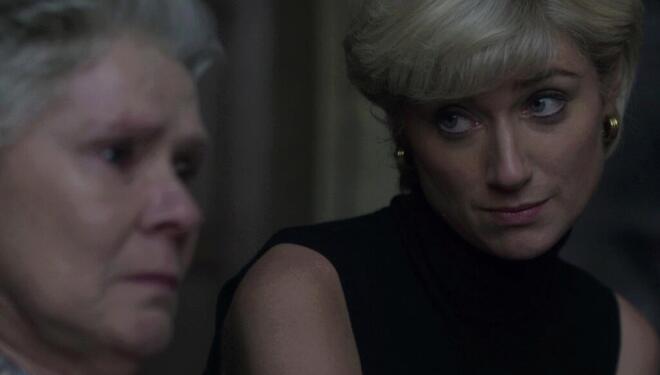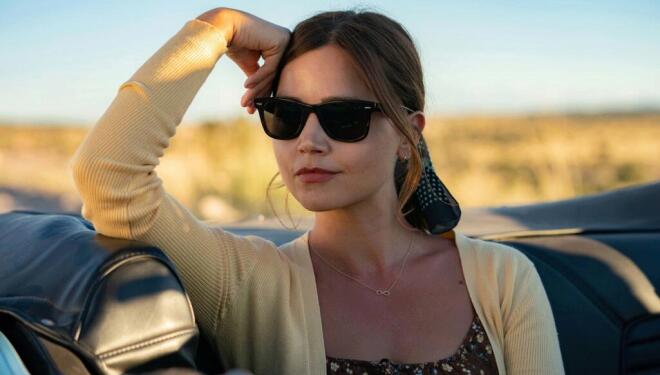
It’s the moment fans have been bracing for, ever since Emma Corrin raised their angelic and youthful face in the fourth season. As with most well-publicised lives that are cut brutally short, the People’s Princess is inseparable from the circumstances of her death.
Writer/creator Peter Morgan’s distance shows more than mere respect, unlike the motorbike tabloid photographers that drove her there and subsequently papped the wreckage. He recovers the unsuspecting life, enjoyed and endured in the weeks before. Rather than entertain what Zadie Smith called the ‘convergence between our horror of death and our love of spectacle’, Morgan focuses on Diana as a person and the lives she touched.

Left to right: Fflyn Edwards, Rufus Kampa and Elizabeth Debicki as Harry, Diana and William. Photo: Netflix
As
always with The Crown, this critic forms an unsteady bridge between
monarchy scepticism and the series’ engrossing and sympathetic creations. But
Morgan is clever, rarely deifying the royals and observing them as people –
albeit among the most affluent people in the world. More than a symbol or icon
or idea, Diana is shown as a decent mother, an adjusting divorcee, and a strong
advocate against landmines. And yet, she’s a woman hounded by cannon-sized
camera lenses and quietly despised by her former in-laws as she tries to have
fun and do good in the world.
There are glimpses of a more morally decent Prince Charles (Dominic West) pushing for Camilla (Olivia Williams) to be publicly embraced into the family, as well as the formative years of Princes William (Rufus Kampa) and Harry (Fflyn Edwards). But Part One is Diana’s show; her closing chapter.
It’s easy to assume the reason behind this season's bisection was to build hype, emulating last year’s controversial Harry & Meghan documentary. But here, it’s creatively fitting: four episodes devoted to the late princess, a month to recover, and then a presumably lighter conclusion on Thursday 14 December involving Will and Kate's meet-cute as well as the marriage of Charles and Camilla. This is the elegiac opening, tackled with decently balanced pathos and a beautiful (if occasionally overbaked) performance by Debicki.

Khalid Abdalla and Debicki as Dodi Fayed and Diana. Photo: Netflix
Admittedly,
Diana’s Mediterranean escapades with Dodi on a boat in Saint-Tropez don’t attract
too much sympathy. They often resemble an oversaturated reality
show with expensive seascapes, punctured by paps floating nearby – demonstrative
of her ephemerally anxious state of being. There’s even a strange line that
summarises this blinkered view of reality, with Diana comparing a landmine victim
to her marriage. But the brighter, more relaxed moments provide sumptuous vignettes
of her happiness, scattered as they are.
This culminates, inevitably, in the post-mortem episode Aftermath, which succeeds as an admirable, even daring, hour of television. Morgan tries not to take sides, treating the Windsors and Fayeds with almost equal weight, though it’s intriguing that the Spencers are almost entirely excluded.
Nevertheless, this episode captures the widespread collective grief of the time: mournful, confused, inconsolable. The nation's formerly stiff spirit is broken in what Queen Elizabeth (Imelda Staunton) calls ‘mass hysteria’. While it’s hard not to disagree with that assessment, the friction between the traditional and the modern is more destructive than ever in Part One. Diana marks the end of an era, literally haunting the Queen and Prince Charles – leaving behind a vast, tragic chasm. It’s bleak, and it hurts.
The Crown, season 6, part 1, is available on Netflix from Thursday 16 November.
| What | The Crown, season 6, part 1, Netflix review |
| When |
16 Nov 23 – 16 Nov 24, ON NETFLIX |
| Price | £n/a |
| Website | Click here for more information |






